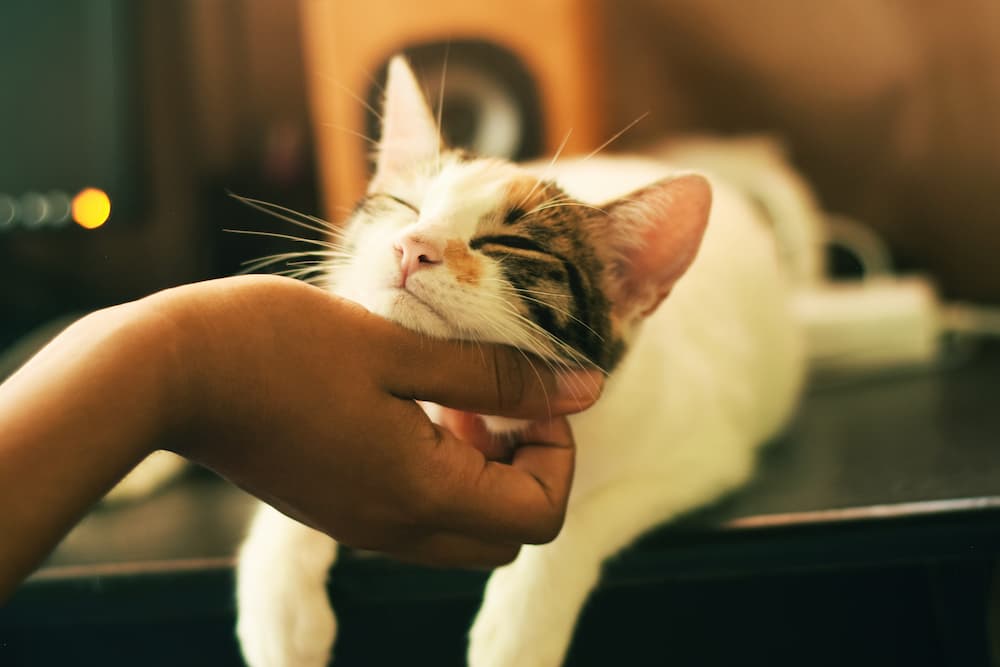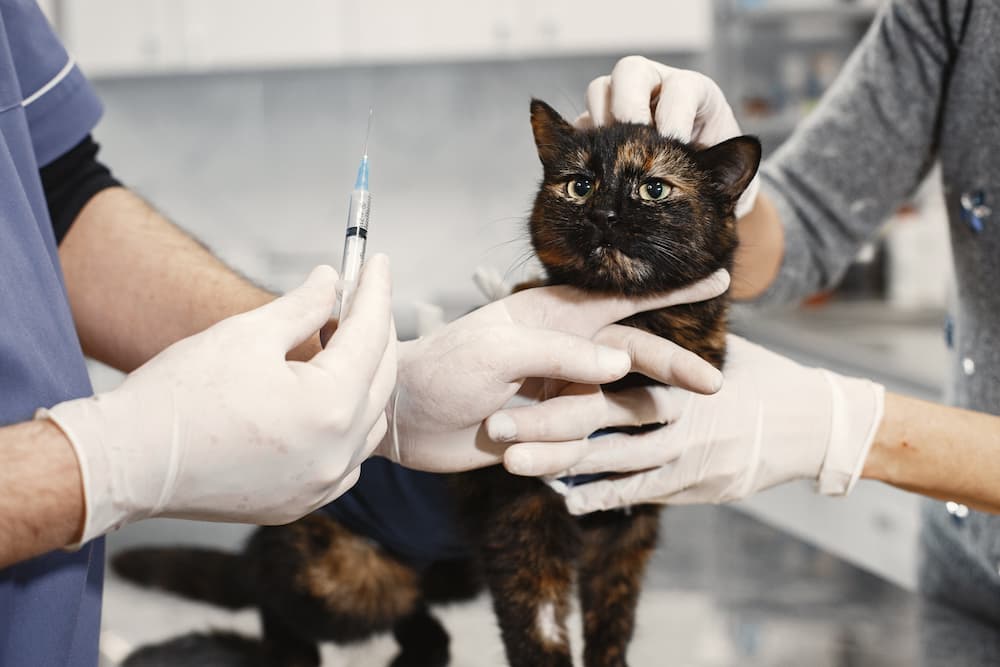-
Like humans, cats develop cat flu that cause a fever and a runny nose.
Cat Flu can be detrimental in kittens and older cats, especially with underlying issues. Although it is not uncommon, more senior, healthier cats are less susceptible to catching the flu. Therefore, it is essential to see a vet if your cat seems poorly.

What Causes Cat Flu?
A recent study estimated that about 80% of cat flu cases were caused by the FHV-feline herpes virus or FCV -feline Calci virus.
These viruses cause the respiratory lining, therefore worsening cat flu symptoms.
Other causes of cat flu are Bordetella, feline chlamydiosis, and mycoplasma.
Understanding these viruses and their symptoms can help treat and assist your cat during a cat flu bout.
FHV (Feline Herpesvirus)
This virus is usually spread by the saliva or the secretions from the eyes and nose of an infected cat.
FHV is commonly seen in kittens, and the symptoms are usually conjunctivitis, ulcers of the eyes, sneezing, fever, and a runny nose.
FCV (Feline Calicivirus)
This virus is spread by contact, i.e., snuggling, rubbing, sharing food bowls, toys, and from people’s clothing after contact with an infected cat.
Symptoms of the virus include drooling, mouth ulcers, sneezing, runny nose, and watery eyes.
FCV goes into remission and may reoccur when your cat is stressed or ill.
Chlamydophila
This is a mild form of cat flu, and often, the most common symptoms are discharge and redness of the eyes.
Bordetella
Bordetella is the leading cause of infectious tracheobronchitis, most commonly known as kennel cough, which affects both dogs and cats. Cats infected with Bordetella often show flu-like symptoms; they may develop a cough too. Bordetella is also a significant cause of high death rates amongst kittens as it causes severe infection.
Can Humans get Cat Flu?
The viruses that cause cat flu in cats (FHV and FCV) are not Influenza viruses and cannot be transmitted to humans.
What are the symptoms?
The symptoms of cat flu can take up to two weeks to show. Here’s what you look out for:
- Sneezing
- Watery eyes and runny nose
- Croaky voice or loss of voice
- Drooling
- Fever
- Sore throat
- Lethargy
- Labored breathing
- Coughing
- Mouth ulcers
- Loss of appetite
How do you treat Cat Flu?
Your vet will aim to tackle the clinical signs of cat flu as there is no direct cure for cat flu.
He will prescribe supportive treatment medication such as anti-viral medication, antibiotics (for any accompanying bacterial infection such as Bordetella and Chlamydophila Felis
) anti-inflammatories and eye drops.
Some kittens and older cats may need to be hospitalized, especially when they stop eating or drinking. The clinic will administer nutritional support or put your cat on a drip during their stay.
Note: When treating cat flu, it is essential to complete the prescribed courses of medication to the end; for example, if your vet suggests eyedrops, you must continue using it even if your cat’s eyes seem cured.
How can I help my cat at home?
If your vet says that you can take your infected cat home, here are a few things you can do to help with their recovery:
Gentle face cleaning
Using warm water and a face cloth, gently wipe your cat’s face making sure to clean the eye area of any secretions or crusting.
Offer strong-smelling foods
Your cat may not have an appetite; therefore, you could hear some strong-smelling food, e.g., sardines, tuna, roast chicken, or pilchards. In addition to nutrition, make sure that your cat stays well hydrated

Humidity
Just as we humans have congestion during the flu, so do cats. If you have a humidifier, keep it near your cat to allow the nasal passages to open. Alternatively, take your cat into the shower with you.
Reduce Stress
Stress plays a significant role in your cat’s road to recovery. Make sure that your cat is in a stress–free environment. Learn more on doing this by keeping an eye out for signs of stress in your cat.
How long does Cat Flu last?
It takes 5 to 10 days for milder cases and up to 6 to 8 weeks for more severe cases for cats to recover, dependent on the type of bacterial infection or virus that your cat has picked up.
Cats that have contracted FHV – feline herpes virus carry the virus their entire lives, only showing signs and symptoms when stressed or if their immunity Is low.
Kittens and older cats with FCV -feline Calci virus show signs of recovery after a few weeks, although they can be carriers for months after the illness.
Preventing cat flu
Ensuring that your cat is fully vaccinated can go a long way in preventing cat flu. Since there are many strains of viruses as with humans, vaccinations cannot help with them all. Two doses of vaccines are initially administered, and thereafter, booster shots.
It is essential to note the side effects vaccinations might have on your kitten; some kittens have allergic reactions such as hives swelling of the eyes, neck, and lips. These reactions may cause difficulty breathing, vomiting, pale gums, and weakness in some severe cases.
Vaccinated cats can also get cat flu, i.e., they become carriers, show no symptoms, and can infect other cats. Your cat’s vaccinations should be kept up to date as with time, vaccinations fade; hence boosters are required.
Some pregnant cats are carriers who show no symptoms and pass on the virus to their kittens; that is why there are many “false vaccination “cases in kittens.
As a cat lover, it may be challenging to see your kitty suffer, and for most of us, we try to assist our ailing pets with home remedies to save money and time however, this could be a deadly decision for your pet. If your cat is Ill, be sure to get in touch with your vet immediately and make sure you take proper instructions on how to care for your cat at home in the appropriate manner.
Author: Lee-Ann Vaz-JolyBusiness Account Manager at The Best Marketing Shop. A skilled digital marketing strategist with a passion for SEO content writing and content creation. In my free time, I enjoy quality time with my family and advocating for animals!
Call (+254)79777779 to schedule an appointment
-
Contact Us
-
09 Mayfair Maisonettes, A2,
Westlands, Nairobi, Kenya
(+254) 797 777179
[email protected]
-
-
About
-
Westlands Vet Clinic is focused on furnishing you and your pets with the very best in veterinary treatment. We will work with you every step of the way to create symptomatic, treatment, and preventive designs that best meet the individualized needs of your pet.
-
Made with ![]() by The Best Marketing Shop
by The Best Marketing Shop

 Facebook
Facebook